We have been to every Rochester International Jazz Festival and I take a few notes on the acts we catch.
2018

We didn’t know the names so we listened to the samples and were left with only a few choices for the opening night of the Jazz Fest. More time to watch the three World Cup matches we had time shifted.
Seventeen years in and we are still able to find free parking downtown we walked by the old Milestones, what was once a venue for the festival, James Blood Ulmer comes to mind, and solo guitarist was playing in the parking lot patio. He had foot pedal rigged to play a tamborine and an old suitcase that played like a bass drum. Can’t even remember what he sounded like. We were on our way to the Xerox Auditorium and we were drawn into the Rhythm Dogs performance in front of the Inn on Broadway. Drawn, that is, by the rock solid R&B drummer, Laris Ashford. Anybody could have played anything in front of that guy. We only lasted a few minutes because it was painfully loud.
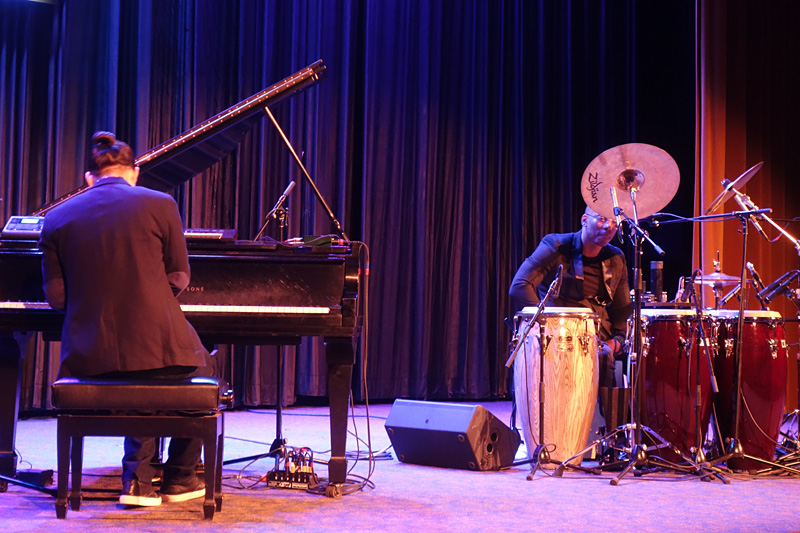
Alfredo Rodriguez and Pedrito Martinez at Xerox Auditorium were a pure joy to hear. We had heard both at past festivals in completely different settings, Rodriguez with his trio at Kilbourn and Martinez leading Cuban dance/pop ensembles. They played fast and furious and then slow and pretty. The classically trained pianist’s free flowing melodies worked magic with the rhythms of the Cuban streets. They played fast and furious and then slow and pretty. We were tempted to return for the second set but the World Cup called.

Marius Neset at the Lutheran Church went from dreamy pretty to frenetic in the same song. Their material was richly orchestrated and executed with near precision. We sat between the piano and vibraphone and those to instruments sounded especially good in stereo harmony. Their arrangements were mostly joyous and the band was clearly having fun so the progressive tendencies remained infectious.

These guys, performing on the street near Hatch Hall, posed for me while they were playing. The drums were about five times louder than the keyboard.

These two street musicians had switched instruments tonight and they sounded great.

The line for the Bad Plus went around the corner to Franklin Street but we weren’t worried, we’d been in this venue, now called Temple Theater, back in the eighties to see Yellowman, Grace Jones and The Replacements and we knew there was plenty of space. I was excited to see the Bad Plus with their new pianist, Orrin Evans. I found him just as melodic but more angular and impactful. The band has carved out their own space with a sound that is hard to pin down. One attribute is a constant. The group playing, one player’s part hanging on the other, creates the sound. I especially liked “Savages,” a hypnotic groove of a song from their new record.

Saxophonist, Sigurdur Flosason, left Iceland to study with David Baker at Indiana University in Bloomington. Peggi Fournier also went to Indiana University but she studied saxophone with Rich Stim. His band was a perfect fit with the Lutheran Church where we sat in the pews contemplating the setting sun through the stained glass windows. He finished with with “Serenading the Moon,” a tribute to Hoagy Carmichael (a Bloomington native)/Johnny Mercer song, “Skylark.” We talked to Flosason after the performance and never mentioned Iceland’s 2-0 World Cup loss to Nigeria.

Django Bates Beloved Trio has a new record produced by Manfred Eicher at ECM. Funny how a record label, Impulse, Blue Note, ECM, informs the sound. To my ears ECM leaves the blues out of jazz. A huge generalization. Bates’s free flowing piano melodies hardly needed the adornment of the rest of the beloved trio.

Melissa Aldana, the Chilean tenor saxophonist at Kilbourn works in a moody, blue territory, steeped in the right parts of the tradition but the band seemed oddly disconnected from the songs. I kept waiting for them to dig in. I might have missed that part. We went home to watch Germany score in theist minute of stoppage time.

We started the night at Montage without knowing anything about the band. The room was packed, standing room only, and it was about thirty degrees warmer than outside. Their air conditioning was not up to the task so they had the back door open and a large fan whirling away. Christian Sands Trio, piano, bass and drums, was tearing it up with a big back beat and showman-like piano swells that had the cro
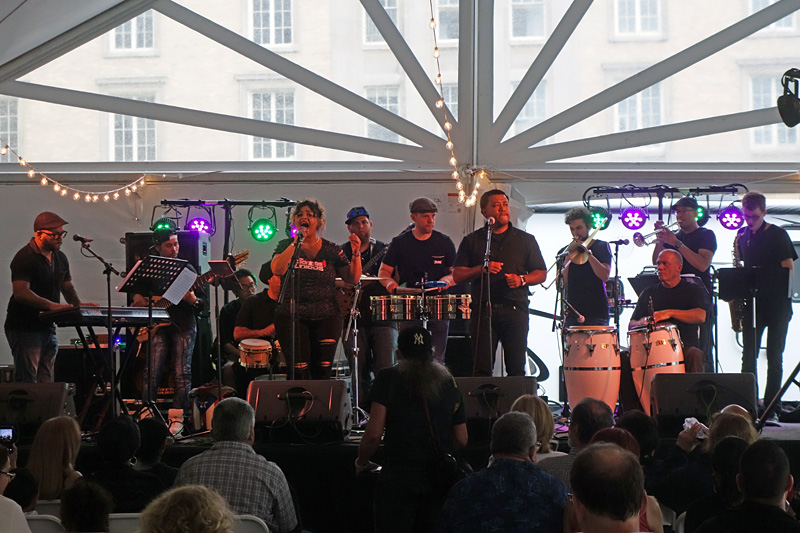
Sonidos Unidos, the popular local Latin music band, had twelve people on the small RG&E tent stage and I counted seven strings on the bass player’s instrument. They always sound good.

It wasn’t until the third song that I realized there was no bass player in this trio. Kuala Trio held themselves together with the space around their perfectly placed parts. Mostly slow, even mournful at times, and always pretty in a sad sort of way. They mixed European folk with classical and jazz and played like a chamber ensemble, at times just sax or sax and drums or long stretches of piano and drums. They were each such great players they made their instruments sound like a million bucks.
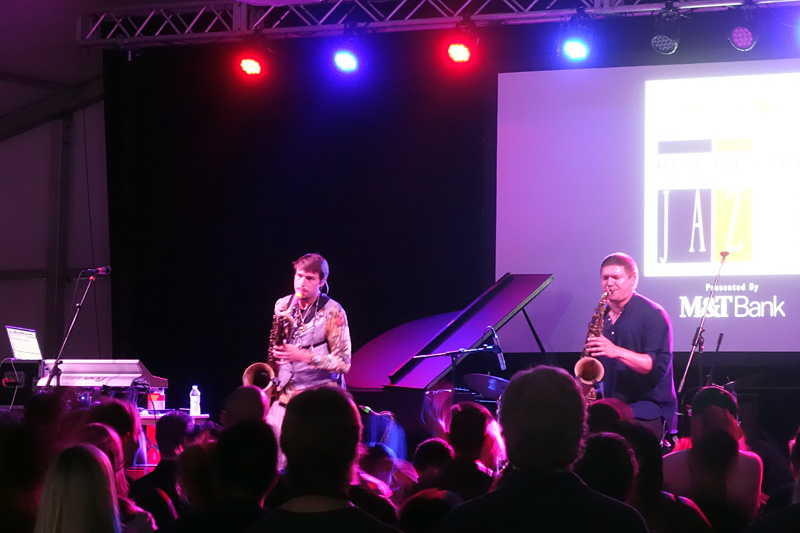
We pushed our earplugs in and stepped into the big tent for a few songs by Moon Hooch. Two tenor sax players darting around the stage like professional wrestlers with a great dancehall drummer. They augmented this sound with some keyboard programming and got the party going on a Sunday night.

We heard Canadian Jane Bunnett, who plays soprano sax and flute, at the very Jazz Festival seventeen years ago and we’ve heard her a few times since, always playing with Cuban musicians. Tonight the band was also all women, on piano, bass drums and percussion. She explores all varieties of traditional Cuban music in a jazz setting and her shows are always joyous.

The soulful singer, Solveig Slettahjell, with the Norwegian band, Trail of Souls, puts a Cowboy Junkies spin on both American and European traditional blues and country. Her beautiful voice and the choice guitar parts added by guitarist Knut Reiersrud bring the backing trio, know separately as In The Country, to life. But just barely and that’s what makes it interesting. The band seems uninterested in melodic and rhythmic counterpoint. The sparse players worked well with the room’s hollow ambience.

I really wanted to like the English soul singer, Zara Mcfarlane. We looked at the 45s they had for sale at the merch table and I was ready to snap one up if I liked the band. The big Christ Church hall was not the right room for them. They might have sounded better in a small club, a setting where there no be as much focus on the singers voice.

Hatch Recital Hall was only half full on Tuesday night. There was a lot going on at other venues. The room is usually reserved for solo performances but pianist, Gary Versace, who graduated from the Eastman, brought the rest of his trio, bass and guitar, up from NYC for the gig. The bass player, Sean Smith, played with Peggi Lee and that impressed me. The three played each other’s tunes with lots of melodic interchange. It was kind of distracting watching them reading their charts while improvising so I closed my eyes and really enjoyed the dialog.

This trio was playing in the old Rochester Club courtyard on East Avenue. The instrument in the center is a bass, a nine string bass.

The tenor sax player in Partikel at Christ Church had some great ideas and I really liked his playing. The arrangements were youthful and energetic and the bass player provided really interesting support but he was hard to hear. For me their sound was lost, almost run over by the frenetic drumming. The guitar player also piled on and the songs lost their steam. It could have been the room swallowing up what I wanted to hear and not the bands’ fault at all.

The vocalist for Speak Low introduced the band, just sax and bass, and told us they were “going to play traditional tunes, standards and folk songs that we arranged for you.” This three piece covered a lot of ground. From abstract and angular to swinging grooves the band was a real pleasure to listen to. The vocalist, just like the name, spoke low more than sang but her low rent chanteuse style was a perfect fit.

The German Youth Orchestra at Xerox Auditorium is comprised of the county’s top young jazz musicians. The kids apply for their positions and their government supports the two year program. Imagine that! They celebrated the 100th anniversary of the Bauhaus movement by performing in front of digitally restored Bauhaus films from the George Eastman collection. Orchestras this big can get mushy but these kids were crisp and clear.

This young band was just finishing up a tune when we walked by Spot Coffee on East Avenue.
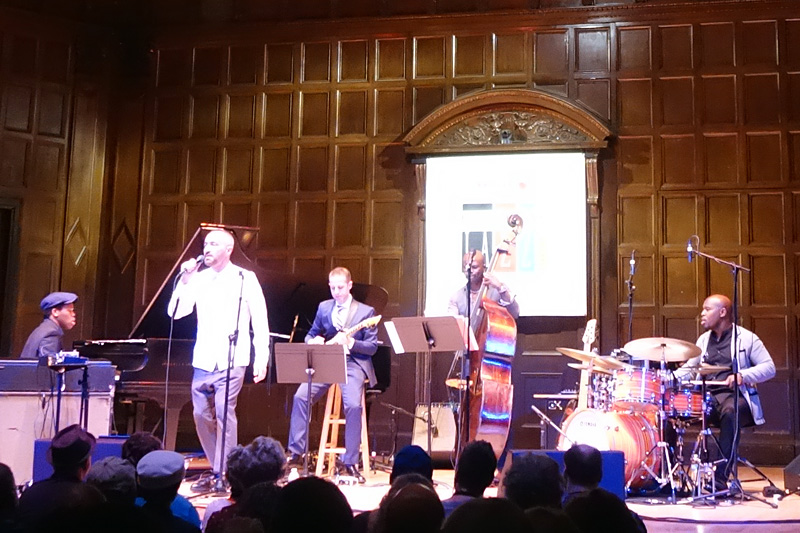
We started the night with Songs of Freedom, drummer and musical director Ulysses Owens’ project featuring interpretations of Nina Simone, Joni Mitchell and Abbey Lincoln featuring the vocalists Alicia Olatuja and Theo B. The band and singers were top shelf, real pros, surely the best musicians we’ll see at the Festival. Still not as satisfying as hearing the original artists they are covering but we don’t have that luxury. They were performing Joni’s “Borderline” above.

We were a little late for everything tonight, the World Cup got in our way again, but we were really late for Liz Vice at Montage. She was just finishing the the last song with a rave u when we walked in. Looked like a real party.
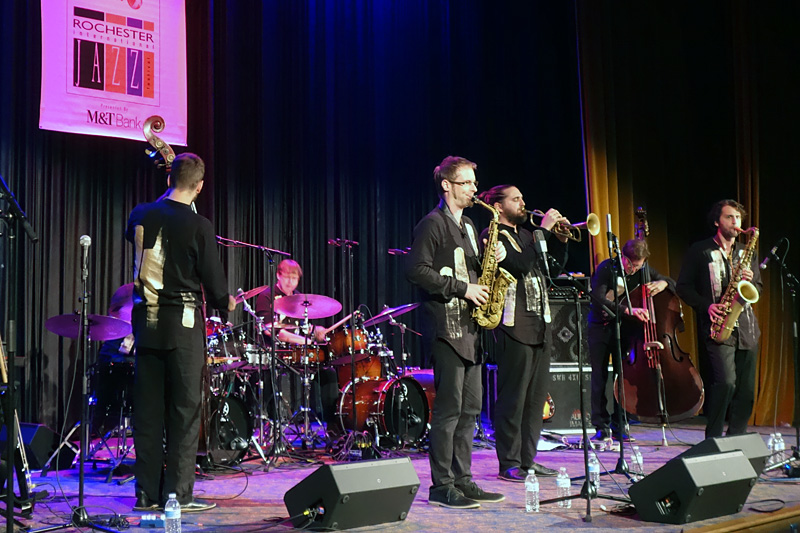
Shake Stew is led by Lukas Kranzelbinder, one of the two bass players in the group. They have have two drummer too and three horns. With a double trio lineup they are more than capable of coming across like a steamroller. But what a ride. I have to say I much preferred being able to hear the interplay in their former band, Interzone, a single trio who played the festival in 2015 and 2017.
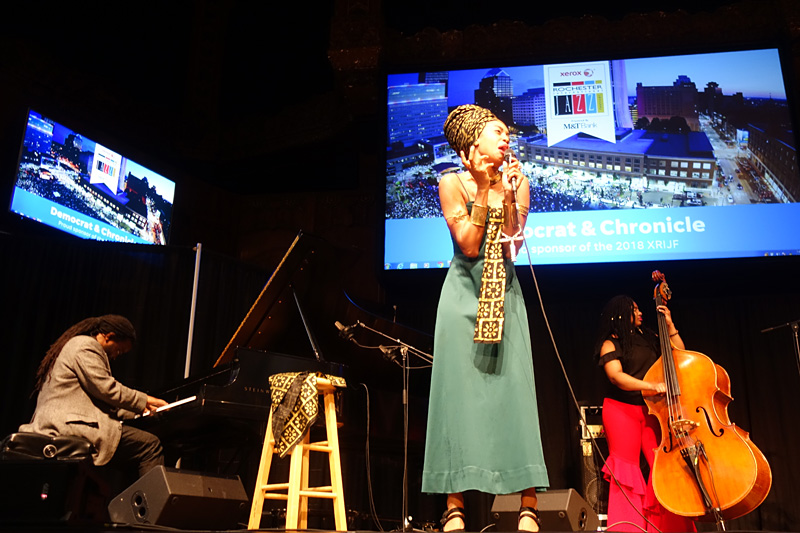
I can’t imagine a more positive attitude than the one Jazzmeia Horn adapts for performance. Positive in sound, message laden self-help lyric and smile. Her bass player and drummer propelled her set. The duo with the piano player put it to sleep.

Some Bourbon Street, some barrelhouse piano blues and some real swagger make Davina and the Vagabonds a festive, festival act. From Louie Jordon to the Lovin’ Soonful, they put their barroom saloon stamp on everything they touched. We had our first beer of the festival, a Goose Island IPA, in the big tent while listening to Davina, who reminded us of our good friend Cheryl Laurro. We were standing next to Phil Marshall who told us he had played with the Vagabond’s bass player.
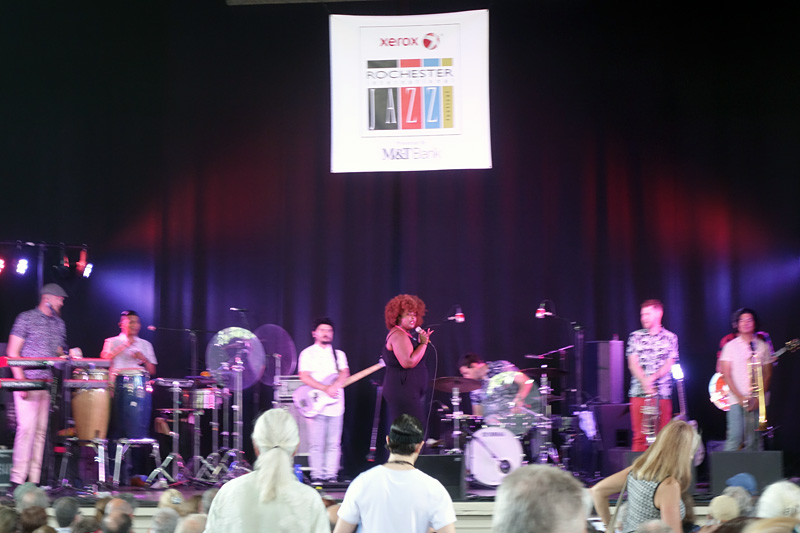
We were downtown earlier than we needed to be be so we stopped in Harro to hear The Suffers, a Gulf Coast band. The lead singer said people ask what Gulf Coast music is and we say it’s anything we want it to be.
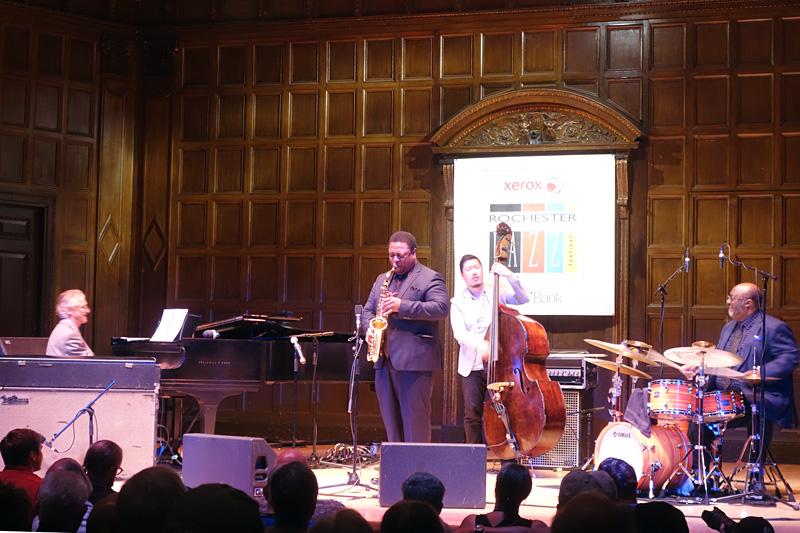
The Vincent Herring Quartet at Kilbourn was very easy on the ears, what I would call “straight ahead jazz.” The bass player, Yasushi Nakamara, was fantastic and the drummer was the former director of the Juilliard School of Music. I could have stayed right there for the whole set and been happy but a band was staring over at Xerox that we wanted to see.

The Quinn Lawrence Band was doing an Amy Winehouse version of Valerie when we stopped in the RGE tent.
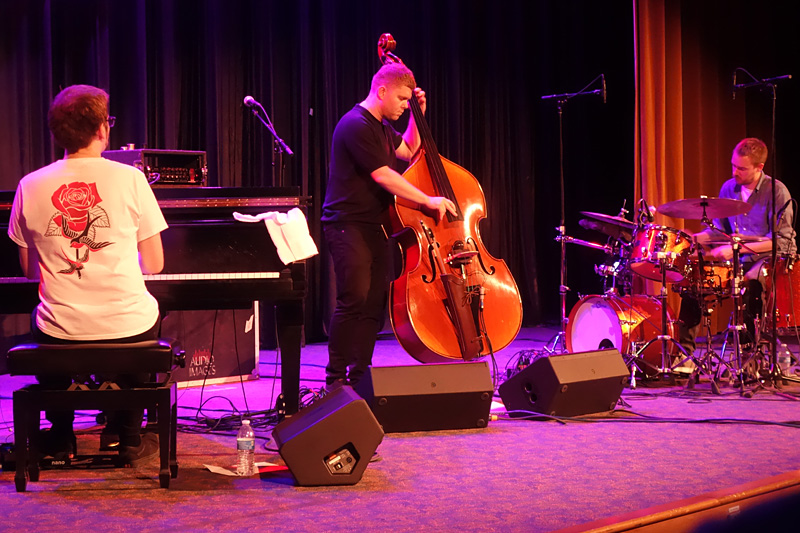
GoGo Penguin sounded much better in Xerox Auditorium than they did in the Church last year. Their trip-hop jazz is moving a little closer to progressive fusion but they are so melodic they will always be interesting. They repeat lines, almost like loops, fractured lines that sound like a vinyl record skipping and they construct arrangements out of these. Songs end just as mysteriously as they form.
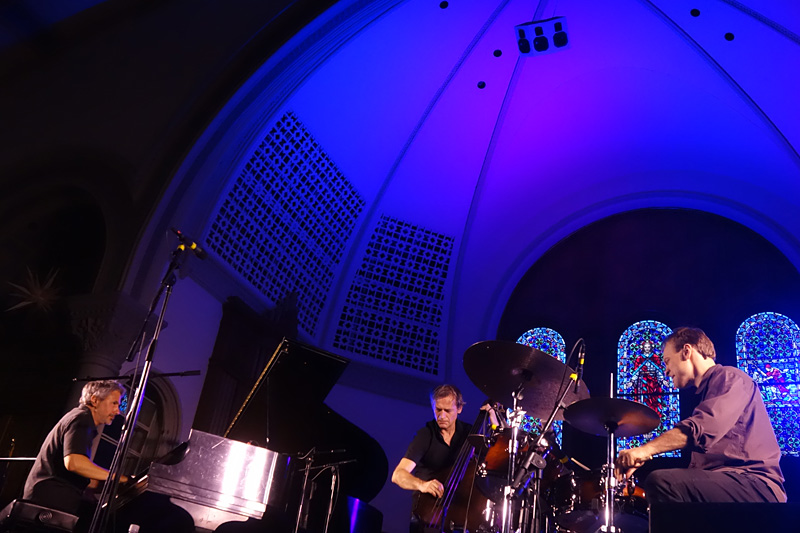
Finally. We heard our favorite band of this jazz festival. The band was introduced, the bass player plucked a few notes and the drummer answered with a few strategically placed taps. Were they just checking their levels? No, they were starting a dialog, one that turned into a cat and mouse game before taking on the form of a fully developed piece. But just as we were digesting that development the piano player stood up and walked away. The bass and drums were revealed in a dramatic new light. He sat back down and piece evolved into something else.
Was Pilc Moutin Hoenig’s set all improvised? Surely they revisit favorite themes. The three were great players but their greatest strength was their arranging. They fearlessly deconstructed their music in the same way they constructed it. The trio was confident enough to explore smaller configurations. Just think of the possible combinations. Piano and bass, bass and drums, bass and piano. Just piano, just bass, just drums. And when it came down to just one instrument wasn’t so much a solo as it was music, played on one instrument. Pilc whistled a tune while accompanying himself with a one note piano repetition. It was brilliant.
They continually let things gracefully fall apart. One of them would duck out of the arrangement and the song immediately took on a new shape. They did this over and over again through the whole night. About thirty minutes into their set they found themselves all playing an ending and they went with it. There was applause. And they went back to work.

What Is It About The French? Jean Michel Pilc kept reminding me of Pete LaBonne, both in his playing and his manner, read understated wit. The self-taught pianist has a book on improvisation too, out of print. We picked one up at the show for a song.

New Orleans’ trumpeter Nicholas Payton at Kilbourn was surprise. His playing was featured in Robert Altman’s film, Kansas City, but we didn’t expect his singing. He is not the strongest but that is the charm. He pulled off a mid-seventies style soft soul tune from his love song album, “Bitches,” and a few slippery jazz numbers. He played samples from his phone which was mounted to his mic stand and he led the crowd in a “Jazz is a Four Letter Word” chant. His father, the bassist Walter Payton, played on Lee Dorsey’s “Working in the Coal Mine.” Those New Orleans routes showed in the amazing drum intro and bass solo in his song, “I Want To Stay In Mew Orleans.”

This fellow was sitting in the middle of Main Street playing the top of a steel drum. He sounded great and had the composure to pose for me while he was playing.

Maciej Obara Quartet at the Lutheran Church took off in a high flying frenzy and didn’t bring it down for twenty minutes. But when they did it was a really beautiful landing. Bowed bass and brushes and clean rhythms. Obara is is really melodic player. They proceeded to take us on a another wild ride, something resembling a car chase. They were cinematic in the I found myself lost in some action movie.

Richard Patterson played bass with Miles in in eighties. I think he was the bass player when we saw Miles at the FLPAC. He holds up the big fort of the Miles Electric Band even though the project was put together by drummer Vince Wilburn. Dedicated to Miles later work, I wish they would have stuck to “Bitches Brew”, “On The Corner” and “Get Up With It,” my personal favorites, but who’s complaining. Although downtown was packed we were able to find a place down front for “Time After Time” and “Guinnever.”. This was the perfect festival band.

Deva Mahal, Taj Mahal’s daughter, was taking it slow and soulful at Harro. Closer to gospel than her father she carries on the messenger role. “Everybody deserves to be free.” It was really refreshing to hear her not get overblown as she continued to draw you in.

The tiny Asian organ grinder, leading the Akiko Tsuruga Trio at Montage, held the room under her spell. It was 1960 all over again. Her crisp accompanists, guitar and drums, were not as gritty as Bill Doggett’s bands but “Misty” never sounded better.
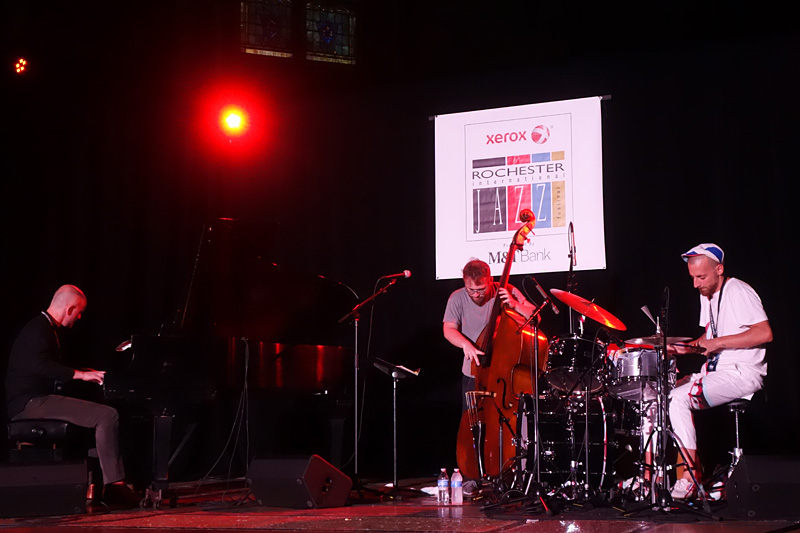
Mark Lewandowski Trio’s tribute to Fats Waller’s music, what bass player, Lewandowski, calls, “the best pop songs of Fats’ day,” paired perfectly with the 90 degree heat. The trio had a light touch, even when playing incredibly fast and especially when playing really slow. They managed to sound great in this cavernous room.

Thomas Stronen plays with no sound reinforcement. Nothing was miced. The sound system was off. The Lutheran Church even killed the fans for the performance. The band is clearly in rarified chamber jazz category. Led by the drummer with piano, double bass, cello and violin, their sound is sparse and somber but not sad, something like an Igmar Bergman movie. They slow your pulse down. I closed my eyes and found myself in a remote, black and white, Norwegian country house. This was a magical ending to this year’s fest.
see Jazz Fest coverage from other years
2019 • 2018 • 2017 • 2016 • 2015 • 2014 • 2013 • 2012 • 2011 • 2010
2009 • 2008 • 2007 • 2006 • 2005 • 2004 • 2003 • 2002
RETURN TO ROCHESTER JAZZ FEST INDEX
